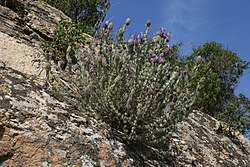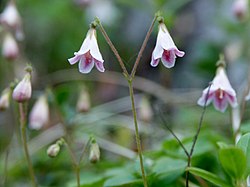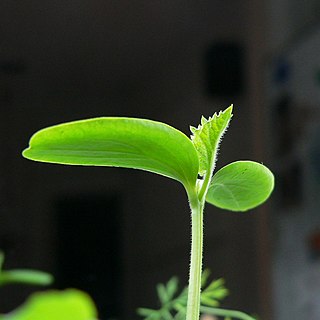
In botany, a plant shoot consists of any plant stem together with its appendages like leaves, lateral buds, flowering stems, and flower buds. The new growth from seed germination that grows upward is a shoot where leaves will develop. In the spring, perennial plant shoots are the new growth that grows from the ground in herbaceous plants or the new stem or flower growth that grows on woody plants.

A shrub or bush is a small-to-medium-sized perennial woody plant. Unlike herbaceous plants, shrubs have persistent woody stems above the ground. Shrubs can be either deciduous or evergreen. They are distinguished from trees by their multiple stems and shorter height, less than 6–10 m (20–33 ft) tall. Small shrubs, less than 2 m (6.6 ft) tall are sometimes termed as subshrubs. Many botanical groups have species that are shrubs, and others that are trees and herbaceous plants instead.
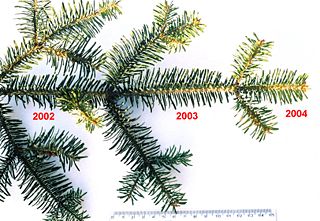
In botany, an evergreen is a plant which has foliage that remains green and functional throughout the year. This contrasts with deciduous plants, which lose their foliage completely during the winter or dry season.

In the fields of horticulture and botany, the term deciduous means "falling off at maturity" and "tending to fall off", in reference to trees and shrubs that seasonally shed leaves, usually in the autumn; to the shedding of petals, after flowering; and to the shedding of ripe fruit. The antonym of deciduous in the botanical sense is evergreen.

Groundcover or ground cover is any plant that grows over an area of ground. Groundcover provides protection of the topsoil from erosion and drought.

Alpine tundra is a type of natural region or biome that does not contain trees because it is at high elevation, with an associated harsh climate. As the latitude of a location approaches the poles, the threshold elevation for alpine tundra gets lower until it reaches sea level, and alpine tundra merges with polar tundra.

Herbaceous plants are vascular plants that have no persistent woody stems above ground. This broad category of plants includes many perennials, and nearly all annuals and biennials.

In botany, a perennial plant or simply perennial is a plant that lives more than two years. The term is often used to differentiate a plant from shorter-lived annuals and biennials. The term is also widely used to distinguish plants with little or no woody growth from trees and shrubs, which are also technically perennials. Notably, it is estimated that 94% of plant species fall under the category of perennials, underscoring the prevalence of plants with lifespans exceeding two years in the botanical world.
A storage organ is a part of a plant specifically modified for storage of energy (generally in the form of carbohydrates) or water. Storage organs often grow underground, where they are better protected from attack by herbivores. Plants that have an underground storage organ are called geophytes in the Raunkiær plant life-form classification system. Storage organs often, but not always, act as perennating organs which enable plants to survive adverse conditions.
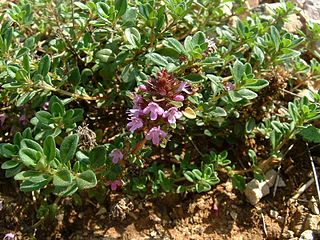
Thymus serpyllum, known by the common names of Breckland thyme, Breckland wild thyme, wild thyme, creeping thyme, or elfin thyme, is a species of flowering plant in the mint family Lamiaceae, native to most of Europe and North Africa. It is a low, usually prostrate subshrub growing to 2 cm (1 in) tall with creeping stems up to 10 cm (4 in) long. The oval evergreen leaves are 3–8 mm long. The strongly scented flowers are either lilac, pink-purple, magenta, or a rare white, all 4–6 mm long and produced in clusters. The hardy plant tolerates some pedestrian traffic and produces odors ranging from heavily herbal to lightly lemon, depending on the variety.

The Raunkiær system is a system for categorizing plants using life-form categories, devised by Danish botanist Christen C. Raunkiær and later extended by various authors.

Shrubland, scrubland, scrub, brush, or bush is a plant community characterized by vegetation dominated by shrubs, often also including grasses, herbs, and geophytes. Shrubland may either occur naturally or be the result of human activity. It may be the mature vegetation type in a particular region and remain stable over time, or a transitional community that occurs temporarily as the result of a disturbance, such as fire. A stable state may be maintained by regular natural disturbance such as fire or browsing. Shrubland may be unsuitable for human habitation because of the danger of fire. The term was coined in 1903.

Garrigue or garigue, also known as phrygana, is a type of low scrubland ecoregion and plant community in the Mediterranean forests, woodlands, and scrub biome.

Habit, equivalent to habitus in some applications in biology, refers variously to aspects of behaviour or structure, as follows:
This page provides a glossary of plant morphology. Botanists and other biologists who study plant morphology use a number of different terms to classify and identify plant organs and parts that can be observed using no more than a handheld magnifying lens. This page provides help in understanding the numerous other pages describing plants by their various taxa. The accompanying page—Plant morphology—provides an overview of the science of the external form of plants. There is also an alphabetical list: Glossary of botanical terms. In contrast, this page deals with botanical terms in a systematic manner, with some illustrations, and organized by plant anatomy and function in plant physiology.
Plant life-form schemes constitute a way of classifying plants alternatively to the ordinary species-genus-family scientific classification. In colloquial speech, plants may be classified as trees, shrubs, herbs, etc. The scientific use of life-form schemes emphasizes plant function in the ecosystem and that the same function or "adaptedness" to the environment may be achieved in a number of ways, i.e. plant species that are closely related phylogenetically may have widely different life-form, for example Adoxa moschatellina and Sambucus nigra are from the same family, but the former is a small herbaceous plant and the latter is a shrub or tree. Conversely, unrelated species may share a life-form through convergent evolution.
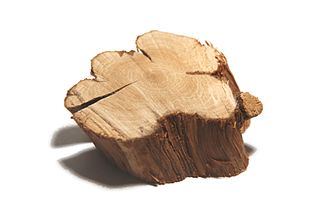
A woody plant is a plant that produces wood as its structural tissue and thus has a hard stem. In cold climates, woody plants further survive winter or dry season above ground, as opposed to herbaceous plants that die back to the ground until spring.
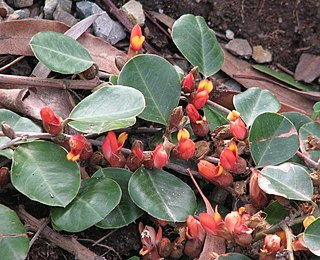
A prostrate shrub is a woody plant, most of the branches of which lie upon or just above the ground, rather than being held erect as are the branches of most trees and shrubs.

In general use, herbs are a widely distributed and widespread group of plants, excluding vegetables and other plants consumed for macronutrients, with savory or aromatic properties that are used for flavoring and garnishing food, for medicinal purposes, or for fragrances. Culinary use typically distinguishes herbs from spices. Herbs generally refers to the leafy green or flowering parts of a plant, while spices are usually dried and produced from other parts of the plant, including seeds, bark, roots and fruits.

The flora of the U.S. Sierra Nevada alpine zone is characterized by small, low growing, cushion and mat forming plants that can survive the harsh conditions in the high-altitude alpine zone above the timber line. These flora often occur in alpine fell-fields. The Sierra Nevada alpine zone lacks a dominant plant species that characterizes it, so may or may not be called a vegetation type. But it is found above the subalpine forest, which is the highest in a succession of recognized vegetation types at increasing elevations.
